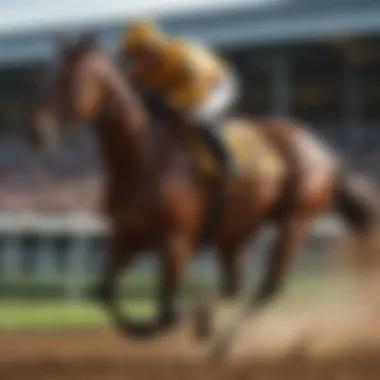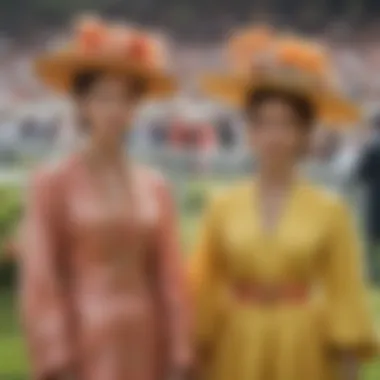Races in Ascot: A Deep Dive into a Historic Event


Intro
Races in Ascot hold a unique place in the landscape of British sporting culture. They are not merely events where horses sprint down a track; they represent a blend of history, tradition, and social dynamics. Each race day becomes a tapestry woven with excitement, rivalry, and the pageantry of fashion. The historical significance of these races, which date back several centuries, is a crucial aspect that has shaped them into a focal point in the sporting calendar. Participation and spectatorship evoke a nuanced experience that goes beyond the thrill of the race itself.
The History of the Sport
Origin and Evolution
The roots of horse racing at Ascot can be traced back to its founding by Queen Anne in 1711. The initial racecourse was designed to provide a venue for royal leisure and sport. Over time, it has transformed into one of the most prestigious racing venues globally. The original intent was to create something exclusive, a gathering for the elite, which still resonates today. The early races were small affairs, but as the popularity grew, they began to attract more attention, leading to the establishment of significant events like the Royal Ascot.
Milestones and Influences
Throughout the years, Ascot has been the site of important milestones in horse racing. The introduction of the Gold Cup in 1807 marked a significant moment, setting a standard for elite racing. The racing format and the strict regulations introduced through various reforms have influenced the manner in which races are conducted. Moreover, the venue has hosted several memorable moments, such as the first victory of the legendary horse Frankel, still celebrated by enthusiasts.
Key Athletes and Pioneers
Various prominent figures have shaped the Ascot races over the decades. Jockeys such as Frankie Dettori and trainers like Sir Michael Stoute have risen to prominence through their achievements at this venue. Their pioneering efforts have pushed the limits of thoroughbred racing and brought a significant level of prestige to the races at Ascot. Notably, the contributions of owners and breeders, who have invested time and resources, have also been instrumental to the sport's growth.
The Cultural Impact of Ascot Races
Social Dynamics
The importance of Ascot stretches beyond the races themselves. The event symbolizes a social occasion where fashion and tradition collide. Each year, thousands come en masse, not only for the excitement of the racing but to showcase their personal style. Hats and tailored suits have become synonymous with the event, reflecting the cultural significance of Ascot in British society. The blend of established norms and modern influence creates an atmosphere like no other.
Economic Impact
Ascot races also contribute notably to the local economy. Both hospitality and tourism sectors benefit from increased traffic during race days. Local businesses thrive on the influx of visitors, creating a ripple effect that bolsters the community. The event attracts global attention, enhancing the tourism appeal of the area and sustaining various local enterprises.
Ending
In summary, the races at Ascot represent more than just competition. They encapsulate a rich history, a robust social event, and a focal point for sporting excellence. The evolving nature of these races, amid shifting cultural and social landscapes, ensures that Ascot will continue to be a significant part of the horse racing tradition in the future. Each race is an invitation to witness a storied tradition that connects history with contemporary life.
Preamble to Ascot Races
The Ascot Races represent more than just a sporting event; they embody a tradition rich in history and culture. The significance of Ascot races extends beyond the excitement of horse racing. This section highlights the role Ascot plays within the broader sporting community, encompassing its legacy and the social dynamics involved. Understanding the introduction to Ascot races provides a crucial foundation for appreciating their historical roots and cultural relevance.
Historical Background
Founded in 1711, the Ascot Racecourse has long been a centerpiece of British horse racing. It was established by Queen Anne, who envisioned a venue where the excitement of racing could be enjoyed by the elite and general public alike. The first recorded race took place on August 11, 1711. Since then, Ascot has undergone numerous transformations, growing in prominence with each passing year.
Throughout history, Ascot has witnessed many notable occasions. For instance, the construction of the grandstand in 1768 marked a significant milestone in its development, enhancing the viewer experience. By the 19th century, the racecourse was firmly established as a staple of British high society. The introduction of Royal Ascot, attended by the monarchy, further solidified its reputation as a prestigious event.
Cultural Significance
The cultural significance of Ascot races cannot be overstated. They are not only a major date in the sporting calendar but also a social gathering spot for many. The races have become synonymous with fashion, elegance, and social status. Attendees often dress in formal attire, and it has become a tradition for women to wear elaborate hats. This cultural aspect intertwines with the races, transforming them into more than mere competitions.
Moreover, Ascot serves as a hub for networking among the elite. Many attendees see it as an opportunity to connect with influential figures in society, making it an event that transcends racing alone.
"Ascot races symbolize the union of sport and society, where tradition meets contemporary culture."


In summary, the introduction to Ascot races lays the groundwork for a deeper understanding of this iconic event. Its historical roots and cultural elements play pivotal roles in the experiences of both participants and spectators, ensuring Ascot remains a significant event in the context of horse racing.
The Ascot Racecourse
The Ascot Racecourse holds a prominent place in the narrative of horse racing, combining both tradition and modernity. Its importance extends beyond the surface of racing itself; it represents a significant cultural and social venue. The design of the racecourse complements the grand spectacles that occur within its boundaries, offering a blend of historical architecture and contemporary facilities. For adventure seekers and sports enthusiasts, visiting Ascot is an experience marked by excitement, competition, and a sense of belonging to a storied tradition.
Overview and Design
The design of Ascot Racecourse is characterized by its impressive layout and innovative facilities. The course stretches over two miles, offering a visually striking backdrop against the rolling Berkshire countryside. The centerpiece of the complex is the grandstand, which has been meticulously designed to enhance the spectator experience. Equipped with over 3,000 seats that provide excellent views of the track, the grandstand is a blend of elegance and practicality.
In addition to viewing comfort, the racecourse also incorporates modern amenities. Several hospitality suites cater to various visitor preferences, ensuring that attendees enjoy the races in style. This design acknowledges the dual role of Ascot – as a sporting venue and a social gathering place.
Renovations and Upgrades
Ascot Racecourse has undergone significant renovations throughout its history, reflecting the evolving standards in sports infrastructure. Major renovations were completed in 2006, significantly upgrading the grandstand and enhancing visitor experience. These upgrades included creating additional viewing terraces, which allow racegoers to enjoy better sightlines of the races.
The focus on sustainability has also influenced recent developments. New initiatives aim to reduce the environmental footprint of the venue while maintaining its prestigious reputation. The installation of solar panels and eco-friendly materials in construction demonstrates a commitment to protecting the environment. Ascot continues to adapt and innovate, ensuring its place at the forefront of horse racing.
Ascot Racecourse not only preserves its rich heritage but actively seeks to improve and modernize for future generations.
In summary, the Ascot Racecourse is a prime example of how a sporting venue can serve both aesthetic and functional purposes. Its design and ongoing renovations showcase a commitment to excellence and sustainability, reinforcing its role as a premier destination for horse racing and social events.
Key Races at Ascot
The key races at Ascot form the cornerstone of this prestigious horse racing venue. These races draw attention not only for their competition but also for their historical significance and cultural resonance within the sport. The events are more than just contests of speed; they encapsulate the essence of racing with deep roots in tradition, style, and prestige.
Royal Ascot
Royal Ascot is arguably the most famous event on the British horse racing calendar. This annual meet occurs in June and attracts a mix of royalty and the elite from all over the world. It spans five days and features a total of 18 races, including several Group 1 events. Each year, this event is a showcase of the best in thoroughbred racing, offering substantial prize money and creating moments that become etched in equestrian history.
Attendance is not just about watching the races; it involves a strict dress code that emphasizes elegance and formality. The event has a dual purpose, merging high-quality racing with social interaction among the upper echelons of society. The atmosphere is electric, with thousands of spectators enjoying not only the racing but also the traditional pomp and ceremony associated with British aristocracy.
King George and Queen Elizabeth Stakes
This race, often referred to as the King George, holds its own special place in the hearts of racing fans. First run in 1951, it is one of the premier races for middle-distance horses, attracting the best competition. The race is run over a distance of one mile and four furlongs, typically in late July. It stands as a prestigious Group 1 race, granting significant prize money and high-ranking international standing.
What makes the King George unique is its ability to pull together a mix of both established champions and up-and-coming stars in the sport. This race serves as a bridge between the flat season and the middle-distance classics.
Important note: The King George often serves as a pivotal point in the careers of many horses, influencing breeding and future races.
Ascot Gold Cup
The Ascot Gold Cup is the oldest and perhaps most prestigious race held at the Ascot Racecourse. Established in 1807, it is a test of stamina for thoroughbreds running over a distance of two miles and four furlongs. This Group 1 race occurs during the Royal Ascot meeting and consistently attracts elite stayers and their trainers.
Winning the Ascot Gold Cup can dramatically elevate a horse's profile and the standing of the trainer. This race has witnessed some of the greatest horses in history, making it a critical milestone for both equestrian fans and industry professionals. The race also often receives attention from wagerers, due to its unpredictable outcomes and high stakes.
Overall, these key races illustrate why Ascot remains an essential part of the horse racing landscape. They contribute to the excitement, history, and social culture that surrounds the sport. Each event offers a unique flavor of competition and continues to draw in audiences who appreciate the blend of tradition and modernity.
Participants and Trainers


The realm of Ascot races is not just defined by the horses on the track; it is equally shaped by the participants and trainers who dedicate themselves to this sport. The jockeys, trained to navigate their steeds with precision, and the trainers, who cultivate equine talent, hold pivotal roles. Their skills and strategies not only influence the outcome of the races but also enhance the overall spectacle of the event. Understanding these key players provides a deeper appreciation for this storied tradition.
Notable Jockeys
Jockeys are often seen as the protagonists of horse racing. Their presence on the course is crucial. They are the ones who command the horse, feeling its rhythm and responding to its needs. Each jockey brings a unique style and approach to riding, contributing to their success and that of their horses.
Some notable figures include:
- Frankie Dettori - A household name in horse racing, Dettori's charisma and talent have won him numerous fans. He has several big wins at Ascot, marking him as a legend.
- Ryan Moore - Known for his tactical acumen, Moore often rides for leading trainers. His focus and experience in major races make him a key contender.
- Hayley Turner - As one of the top female jockeys, Turner has broken barriers in a male-dominated sport. Her achievements at Ascot inspire many.
These jockeys do not just compete; they embody the spirit of horse racing, bridging the human-animal connection that defines this tradition.
Renowned Trainers
Trainers are the backbone of the horse racing industry. They spend years cultivating talent, often investing tremendous effort in preparing both horse and jockey for the demanding environment of the racecourse. A successful trainer understands the nuances of each horse, tailoring training regimens to maximize potential.
Among the most respected trainers, we have:
- Sir Michael Stoute - Renowned for his methodical approach, Stoute has numerous accolades. His careful nurturing of horses is often reflected in their performance.
- Aidan O'Brien - An iconic figure in the sport, O'Brien manages a multitude of horses and consistently produces high-quality competitors.
- John Gosden - Known for his strategic insights and ability to handle elite horses, Gosden’s stable often shines at prestigious events.
Effective trainers create not just champions, but a lasting impact on the sport, cementing their legacy within the racing community.
The synergy between jockeys and trainers is fundamental. Their collaboration is vital, ensuring that each participant at Ascot races is prepared for the challenges ahead.
Betting at Ascot
Betting is a fundamental aspect of horse racing, enriching the overall experience for spectators and participants at Ascot. It serves not only as a means of engagement but also as a significant revenue stream for the racecourse. The thrill of placing a bet adds a layer of excitement to the event and transforms passive viewing into active participation. Understanding the various forms of betting and how odds function is essential for anyone looking to engage fully with the races.
Types of Betting
At Ascot, there are several types of betting options available to attendees. Each type has its unique mechanics and appeal:
- Win Bets: The most straightforward form of betting. A win bet means the bettor selects a horse to finish first in a race.
- Place Bets: A place bet wins if the selected horse places in the top two or three, depending on the race type.
- Each-Way Bets: This combines win and place bets. The total stake is divided into two parts; one part is for the horse to win, while the other is for it to place.
- Exacta and Quinella: These involve selecting the first two finishers in a specific order or any order, respectively. They often yield higher payouts.
- Trifecta: This requires punters to predict the top three horses in the correct order. It offers substantial returns but is more difficult to win.
Betting at Ascot allows for personalization of the experience, making it more thrilling. Each method has its intricacies and requires knowledge of the horses and their performances.
Understanding Odds
Odds convey the probability of a horse winning or placing in a race. At Ascot, understanding odds is crucial for successful betting. Here’s an outline of how odds work:
- Decimal Odds: Commonly used in many regions. It reflects the total payout including the original stake. For example, odds of 5.0 mean a £1 stake returns £5.
- Fractional Odds: Traditional for British racing, displayed as fractions such as 5/1. This means for every £1 wagered, £5 profit can be made if the horse wins.
- American Odds: Depicted as either positive or negative. Positive odds show profit on a £100 bet, while negative odds depict how much must be wagered to win £100.
Understanding these odds can make a significant difference in defining your betting strategy at Ascot. Taking the time to research and analyze horse performances, trainers, and previous race conditions can enhance your chances of success.
Overall, engaging in betting is much more than just placing a wager. It is about strategy, knowledge, and an appreciation for the sport's unpredictability. Ascot's betting landscape is rich and varied, offering enough options for every type of adventurer.
Social Aspects of Ascot Races
Ascot races represent more than just horse racing; they are a cultural event steeped in tradition, sophistication, and social interaction. Understanding the social aspects of these races is essential for appreciating their significance in both contemporary society and historical context. As an event that attracts a diverse audience, Ascot fosters unique experiences that intertwine with fashion and networking opportunities.


Fashion and Attire
At Ascot, fashion is not merely an accessory; it is a integral part of the racing experience. The annual Royal Ascot meeting exemplifies this culture, where the dress code is both strict and imaginative. Each year, attendees don outfits ranging from classic to avant-garde, making the event as much about the clothes as it is about the horses.
For women, elaborate hats are a hallmark of Ascot fashion. These headpieces vary widely in style and size, often becoming a statement piece for the outfit. Men typically adhere to traditional formal wear, featuring morning suits and top hats. This emphasis on attire serves a dual purpose: to showcase elegance and imbue a sense of occasion, while also marking the races as a social gathering of the elite.
Fashion at Ascot invites debates about class, identity, and creativity. Each outfit can be seen as a reflection of personal style and status. In this way, fashion also encourages community among attendees, as individuals come together in shared celebration of sartorial splendor.
Networking Opportunities
The Ascot races function as a platform for networking. Professionals from various industries converge at this high-profile event, creating a unique environment for business and social interaction. The atmosphere is conducive to forming new connections and reinforcing existing ones.
Many guests seize this chance to engage in discussions that extend beyond casual small talk. Networking at Ascot often leads to fruitful relationships, collaborations, and business deals. Such opportunities are not confined to the grandstands; lounge areas and hospitality suites provide ideal settings for more intimate exchanges.
In a landscape where social capital holds significant value, attending the races is a strategic move for professionals. This association with a prestigious event lends credibility to one's status within their industry. Overall, the social aspects of Ascot races extend well beyond the thrill of betting and watching horses run; they encapsulate a multifaceted experience that combines style, status, and the forging of relationships.
The Future of Ascot Races
The Ascot Races have established themselves as a prominent fixture in the world of equestrian sport. However, looking towards the future presents both challenges and opportunities. Understanding the future of these races is crucial as it influences not only the sport itself but also the broader context of cultural heritage and economic impact.
One major factor is the changing audience demographics. The attendance and participation patterns at Ascot are evolving, reflecting a more diverse and younger crowd. To keep the spirit alive, the Ascot race organizers must engage these new spectators with fresh and innovative experiences. This includes leveraging technology for enhanced interaction and gamifying the betting experience, making it more appealing to younger people. Moreover, the digital streams of races attract global audiences. Therefore, the Ascot Races hold a pivotal role in adapting to these evolving expectations, ensuring that it remains relevant and accessible.
Evolving Audience
The Ascot Races will need to adapt continually to the shift in its audience. Young people today engage with events differently than previous generations. Factors such as social media influence play a significant role in shaping their interests and participation. Races are not just about the horses; they are social occasions where the experience counts.
To attract a more diverse group, Ascot can focus on partnerships with influencers who resonate with younger audiences. Observing trends in fashion, food, and entertainment can also inform how the races can enhance their atmosphere, catering to modern tastes and preferences. For instance, incorporating live music and gourmet food stalls could elevate the experience beyond the races themselves.
Moreover, offering educational sessions about horse racing for novices could encourage interest from a broader segment of the public. Targeting schools or universities with promotional events could raise awareness and establish long-term interest in the sport.
Sustainability Initiatives
As the world increasingly focuses on sustainability, Ascot must follow suit. Efforts toward environmental sustainability will be paramount in the upcoming years. Races can incorporate greener practices to reduce their carbon footprint. This could include utilizing renewable energy sources, implementing waste reduction programs, and considering the impact on local wildlife and ecosystems.
The investments in sustainability not only address the concerns of modern audiences but can also position Ascot as a leader in eco-friendly practices within the sporting world. Collaborating with environmental organizations or launching initiatives that promote local biodiversity could also enhance the racecourse's reputation. Furthermore, programs that promote sustainable transport options for attendees could ease the congestion and environmental burden on event days.
The future of Ascot Races depends on its ability to adapt to an evolving audience while embracing sustainable practices.
End
In considering the Ascot races, it's essential to grasp how these events embody a rich tapestry of tradition and modernity. The Ascot races are more than mere sporting events; they represent a cultural phenomenon that has evolved over the centuries. Each race carries the weight of history, accompanied by an aura of prestige that draws participants and spectators globally.
Reflection on Traditions and Innovations
Tradition in Ascot races is evident in the elaborate ceremonies, the royal patronage, and the long-established race schedules. These elements create a unique experience that resonates with visitors. However, the importance of innovation cannot be overstated. Ascot continuously adapts to meet the needs of a changing audience. This balance between honoring the past and embracing the future is crucial.
Key Considerations
- Preservation: Maintaining traditional elements helps to foster a connection to Ascot's illustrious history.
- Adaptation: Embracing new technologies and practices ensures sustainability and relevance in today's fast-paced world.
The future of Ascot races should build upon its storied past while welcoming new experiences that appeal to diverse spectators. This dual path ensures that Ascot remains a significant player in the global sporting landscape, continually drawing interest and admiration.
In essence, the Ascot races are a confluence of tradition and innovation. This dynamic relationship nurtures a unique culture that enhances the overall experience for all who participate. As Ascot strides into the future, its ability to blend these elements will be a defining factor in maintaining its status as a premier racing venue.
"At Ascot, the past and the present come together, creating an enduring legacy that captivates audiences."
To comprehensively appreciate the significance of Ascot races entails recognizing this delicate balance. The enduring traditions are what attract many but it is the innovations that keep the event moving forward.







